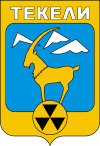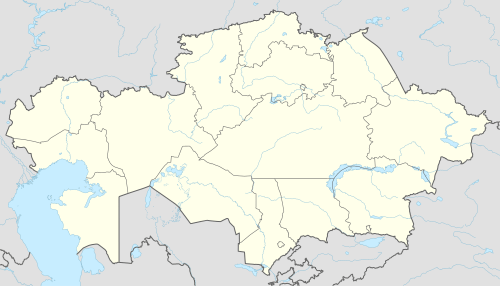Tekeli, Kazakhstan
Tekeli (Kazakh: Текелі, Tekeli) is a city in the Almaty region of Kazakhstan, located 310 km from the Almaty city and 40 km from the Taldykorgan city. At the beginning of 2019, the population of the city is 31,958 people.
Tekeli Текелі | |
|---|---|
Town | |
 Seal | |
 Tekeli Location in Kazakhstan | |
| Coordinates: 44°49′48″N 78°49′26″E | |
| Country | Kazakhstan |
| Region | Almaty Region |
| Government | |
| Area | |
| • Total | 40 sq mi (100 km2) |
| Population (2013) | |
| • Total | 29,960 |
| Time zone | UTC+6 (ALMT) |
| Postal code | 041700 |
| Area code(s) | 72835 |
| Website | http://tekeli.zhetysu.gov.kz |
History

Determination and further development of Tekeli started in the 1920s when Dzhungar Survey Expedition revealed rich mineral deposits near the future town location.
In 1927 there began a more structured search for deposits of minerals in Dzungarian Alatau Mountains. The year of 1933 was prominent for discovering a deposit of polimetals such as lead, zinc, silver, cadmium and germanium. In 1939 construction of the Tekeli Lead-Zinc Factory was started. Concurrently development of a settlement was started for the miners which would become the future town of Tekeli. The development and life of the city depended of the "Lead-Zinc industrial complex", which was one of the largest in the USSR. During the II World War, this Deposit gave the country lead for every eighth bullet. Later, in the post-war period, the Tekeli village began to increase in size, the construction of residential buildings was declared a shock construction site, and a stream of volunteers arrived from all over the Soviet Union. Homes and industrial facilities in the Tekeli built not only by visiting builders, but also by Japanese prisoners of the II war. In 1952, the village granted the status of a city. The Tekeli grew and developed rapidly. Residential blocks built here, kindergartens, schools, parks and cinemas built. It was incorporated on January 29, 1952 by the decree of Kazakh Soviet Republic Presidium. The name of the city comes from the species of animals that once lived in abundance in the gorges of these rivers: Teke - mountain goat, skiff - a small antelope. Hunting scenes of the Uisun tribes depicted on rock paintings near the city. The city of the Tekeli is located in the upper reaches of the Karatal River in the foothills of the Dzungar Alatau, at the confluence of the Kora (Karoy, karinka), Chazhi (Chizhi, Chizhinka) and Tekelinka rivers. The city also had the only electrified narrow-gauge railway in Kazakhstan. Dismantled in the early 2000s.
Tekeli has been subject to conflicts between the government and Krishna believers in recent years.[1]
Education
Tekeli will host one of the three campuses of the University of Central Asia (UCA) founded in 2000 by the governments of Kazakhstan, the Kyrgyz Republic and Tajikistan, and His Highness the Aga Khan.[2] It is the world's first internationally chartered institution of higher education. UCA currently operates a School of Professional and Continuing Education (SPCE) in Tekeli[3] which is a leading provider of post-secondary, short-cycle education as well as an academic publisher in the region. The Tekeli campus will offer Bachelor of Science and Bachelor of Arts degrees in Engineering Sciences and Business and Management[4] and is anticipated to open in 2022.
Famous natives
In this city was born the soviet weightlifter Yuri Zaypulayev ex champion among juniors in the Kazakh SSR. In 1842, the famous Kazakh Akyn and zhyrshy Baktybay Zholbarysuly were born in this region.
Sight of the city
There are several attractions in the city of Tekeli, namely: 1. A street named after Dinmukhamed Kunaev with a length of about 38 km and is Officially recognized as the longest street in Kazakhstan. 2. "The Tekeli Stela", "The Kelinshektas" - the oldest Buddhist monument in the territory of Kazakhstan. 3. "The Burhan Bulak" is the largest waterfall in Kazakhstan, located in the upper part of the Kora River, near the Tekeli city. 4. The Monument-Stele of the great Patriotic war (1941-1945), located in the center of the city at the confluence of three rivers.
References
- http://www.bvml.org/CE/kazakhstan4.html
- "About the University of Central Asia (UCA) - University of Central Asia". www.ucentralasia.org. Retrieved 2016-10-10.
- "The School of Professional and Continuing Education (SPCE) - University of Central Asia". www.ucentralasia.org. Retrieved 2016-10-10.
- "Undergraduate Programme - University of Central Asia". www.ucentralasia.org. Retrieved 2016-10-10.
